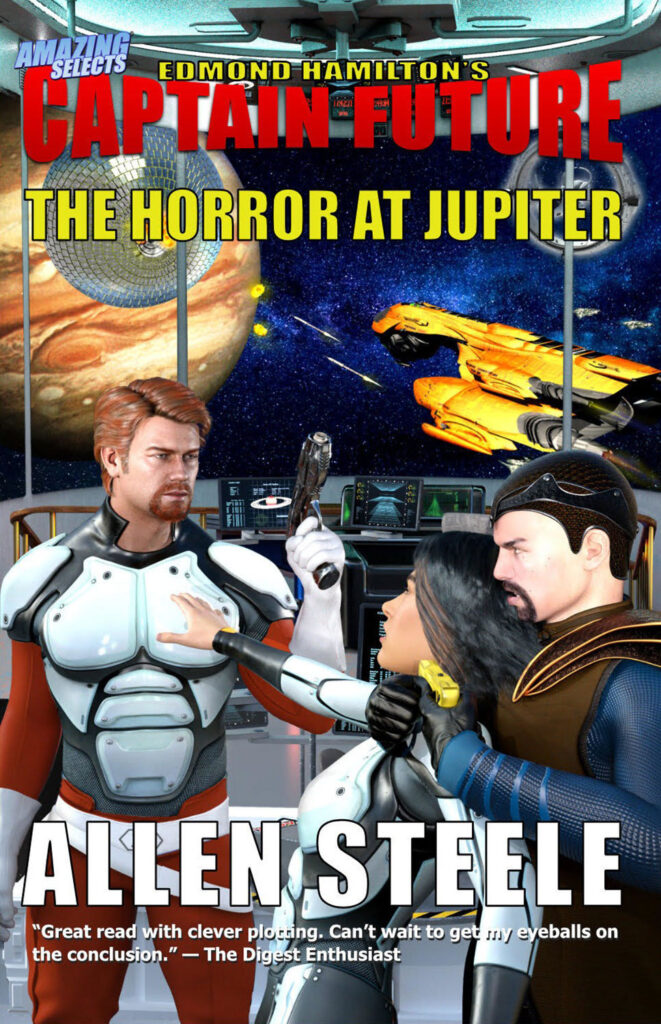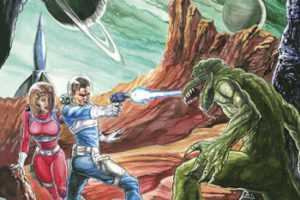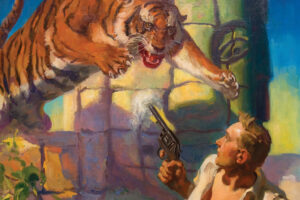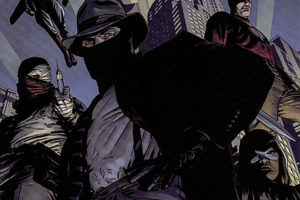We finally get the final of the four novellas in the new Captain Future sequence “The Return of Ul Quorn” by Allen Steele: “The Horror at Jupiter.” This answers the cliffhanger that we got in the last one, and it completes the planned trilogy that started with revamped origin story, Avengers of the Moon. More on that later.
 Coming from the Experimenter Publishing Co., the publisher behind the current Amazing Stories, “The Horror at Jupiter” appears as the latest issue of the new “magazine” Edmond Hamilton’s Captain Future. And, I guess, the last issue.
Coming from the Experimenter Publishing Co., the publisher behind the current Amazing Stories, “The Horror at Jupiter” appears as the latest issue of the new “magazine” Edmond Hamilton’s Captain Future. And, I guess, the last issue.
For those not aware, Captain Future was originally published by Ned Pine‘s Thrilling Publications and was created by Edmond Hamilton.
Inspired by Doc Savage, Curtis Newton was raised on the Moon after the murder of his parents by criminals. He was raised by three beings: Dr. Simon Wright, whose brain was encased in a enclosure after his body died; Otho, a synthetic being created by Newton’s parents; and Grag, an intelligent, self-aware robot. These three will be his “Futuremen.” Otho and Grag have their own bizarre alien pets: Oog and Eek. Together, they operate as a special group of troubleshooters for the president of the Solar System.
A long-time fan of the character, science fiction author Allen Steele revamped him. This is difficult to do well, as one has to balance being true to what the original character is about, while also “updating” the character and his world for a modern audience. Too often authors fail at it, which is why I prefer they instead create their own characters rather than mess-up original ones. But I think here, Steele did a good job of balancing the two. Avengers of the Moon (2017) was his revamp of the Captain Future origin story. It was originally planned as the first of a trilogy of novels, but that never happened.
Set five years after the events of Avengers of the Moon, “The Return of Ul Quorn” sequence is about the Magician of Mars, Ul Quorn, Captain Future’s main villain who was thought to be dead.
In the first part, “Captain Future in Love,” Curt and friends go after a terrorist attempt on Venus, and when he finds that the female terrorist is an old flame, he recalls when they first met on Venus when he was a boy. At the same time, a mysterious figure calling himself the Black Pirate hijacks a luxury spaceliner near Saturn. In the second part, “The Guns of Pluto,” we learn that the Black Pirate is Ul Quorn, the Magician of Mars, and this is all part of his plot to use the spaceline with a new experimental warp drive to get to Deneb, a distant, bright star that has a strange connection to the solar system (and also to one of the Futuremen’s pets). He succeeds, taking Capture Future (and that pet) with him. These two parts comprised what was to be the second novel.
In “1,500 Lightyears from Home,” we find out what they discover on Deneb. I think this deviates from the original Captain Future. While in the original series, they are able to travel to other star systems, including Deneb, what they found here is new.
In this story, we learn who the Denebians are (or were), how Oog fits in, and a bit of what Ul Quorn is after. I won’t spoil it.
Captain Future is able to return to our solar system a month later, and when he meets with the President, we are left with a big cliffhanger. This cliffhanger is resolved in this story, and these two parts comprise the planned third novel.
Thus, in “The Horror at Jupiter,” we first up get the resolution to that cliffhanger. I wondered how it would play out, and it was well handled. And Ul Quorn and his crew return from Deneb with a deadly weapon, and arrive near Jupiter. This was what he had hoped for when going to Deneb, to try to find something with which he can use for his goal: to “liberate” Mars and the outer colonies from the Solar Coalition, and, I’m sure, with himself having a great deal of power in that new government. But can Captain Future and his friends stop him?
Overall, this was a good conclusion to the story. We also get some nice conclusions to a couple of plotlines, and things are setup such that others could do further stories. But would they do as well?
Also, in this volume is a long essay by Steele. “How The Galaxy Was Won: The Early History of Space Opera” is a partial history of science fiction with a focus on the development of the “space opera,” but also Steele’s thoughts on where it could go. As someone who did enjoy early sf space opera stories and has enjoyed some works that seem modern equivalents, we have some interesting ideas here.
And that wraps things up. As I said, I really wish we could get further Captain Future stories. I know the author and publisher hope to have all of these works reprinted into a proper trilogy of volumes. It would be nice to see that happen, though I am satisfied with my copies. I would like to see further stories.
If you wish to read the originals, there are a few options. Steeger Books has issued them all as ebooks. Haffner Press has been reprinting them in large hardbacks, four novels to a volume. I am awaiting my pre-order for the second printing of the first volume and the release of the fourth volume. I’m not sure how many more volumes are needed for the rest. You might also be able to find the old paperback reprints from Popular Library paperbacks.
But certainly, your should check out these new versions by Allen Steele. At a minimum, they show the right way to revamp classic characters.



